The Moto G (2015) Review
by Brandon Chester on August 19, 2015 8:00 AM EST- Posted in
- Smartphones
- Mobile
System Performance
Like the 2015 Moto E, the Moto G uses Qualcomm's Snapdragon 410 MSM8916 SoC. This is the first time Motorola has updated the SoC in the Moto G, with both the first and second generation models using the same 1.2GHz Snapdragon 400 SoC. Because the Moto G shares an SoC with the Moto E one might think this means they are equal in speed. However, the SKU in the Moto G has a peak frequency of 1.4GHz rather than the 1.2GHz in the Moto E. This is somewhat confusing because both are named MSM8916, but it's not dissimilar to how Snapdragon 615 devices run at either 1.5GHz or 1.7GHz on the big cluster.
As far as clock speed goes, the Moto G is 17% faster than the Moto E. It's difficult to estimate how much improvement will be seen compared to the older Moto G models, as the core architecture moves from Cortex A7 to Cortex A53 which comes with its own improvements in IPC in addition to the higher clock speed. It's also important to note that we are testing the model of the Moto G with 2GB of RAM, and this is another factor that can increase performance when comparing to Motorola's 1GB devices. Ultimately, it's important not to assume how much faster the Moto G will be based purely on the CPU frequency, even though it can give some idea about performance relative to other devices with the same CPU but a lower frequency. In order to properly characterize the Moto G's performance relative to many other devices, we turn to our standard workflow of web based benchmarks, followed by PCMark and BaseMark OS II.
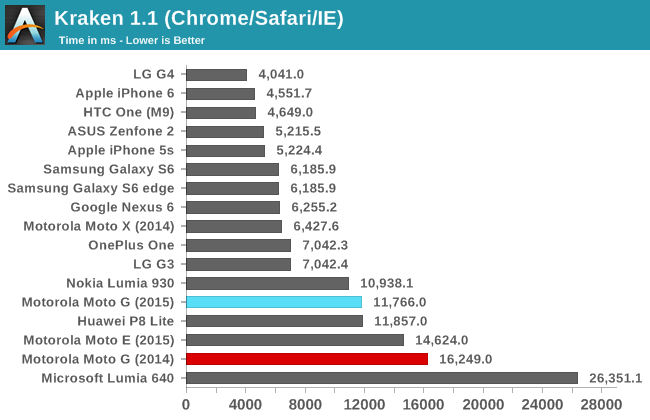
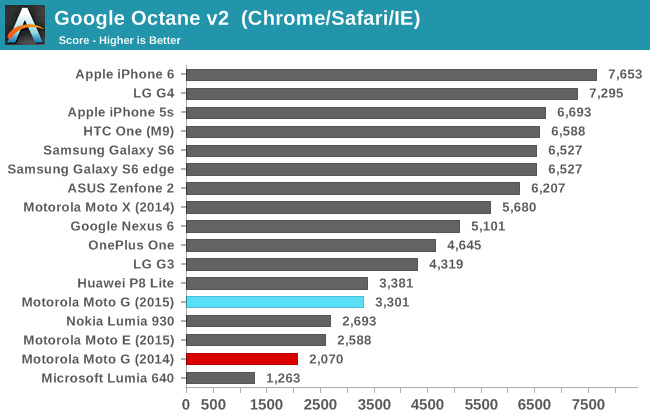
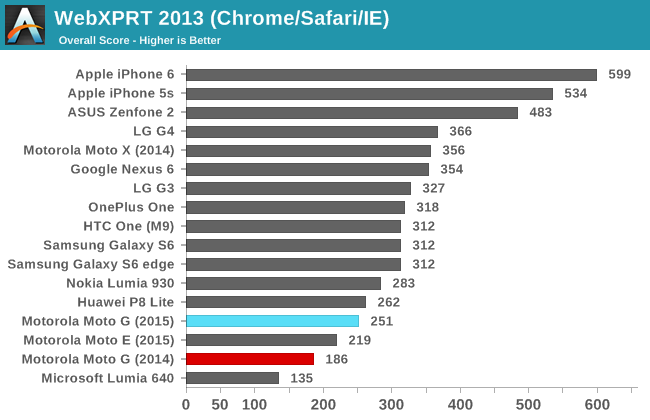

The overall picture painted by our web browser tests is that the 2015 Moto G has a healthy lead over the Moto E's performance, and an even greater one over the older Snapdragon 400 based models of the Moto G. The level of performance is certainly good for a $219 device, but I do find myself wishing that Snapdragon 410 and 615 were produced on 28nm HPC or 28nm HPm in order to achieve even greater performance without an increase to power consumption.

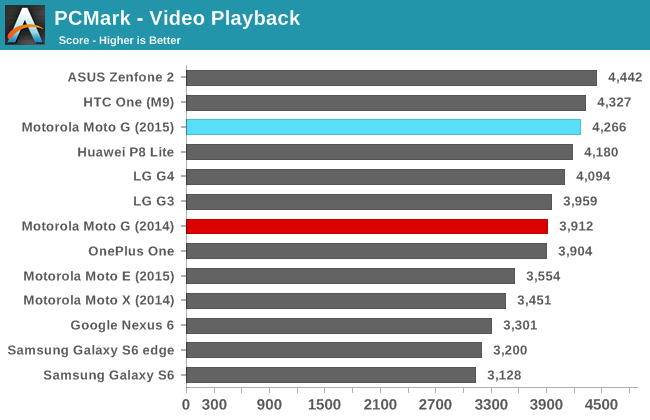
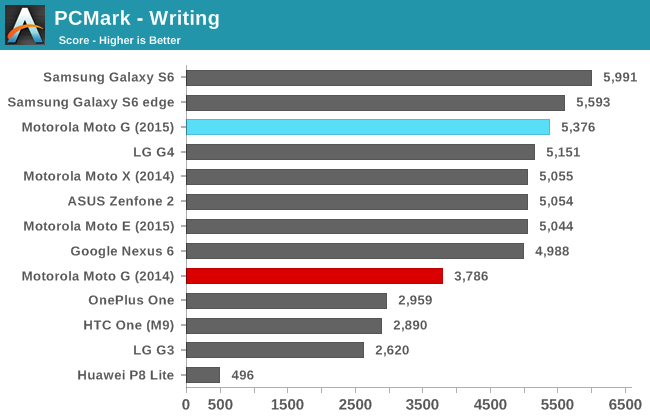
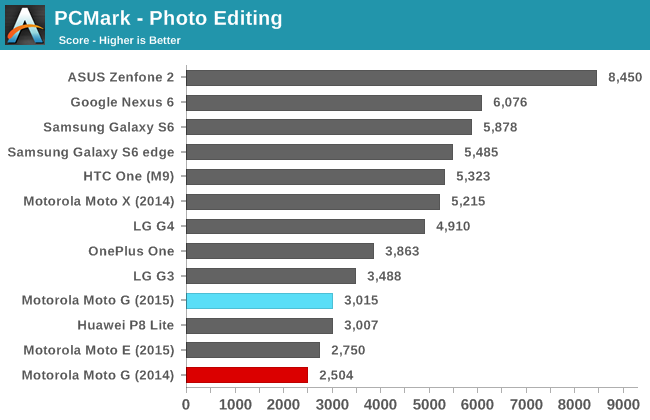
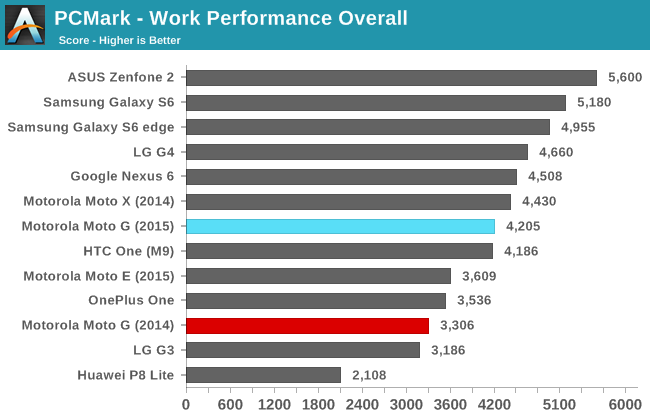
In PCMark, which focuses heavily on replicating real world tasks like watching video and editing photos, the 2015 Moto G again has a strong showing. Overall performance actually sits about the HTC One M9, carried by high scores in the writing and video playback tests. Web browsing performance also improves significantly from the 2015 Moto E and the 2014 Moto G, which could either be the result of additional memory or further optimizations to the Android WebView.
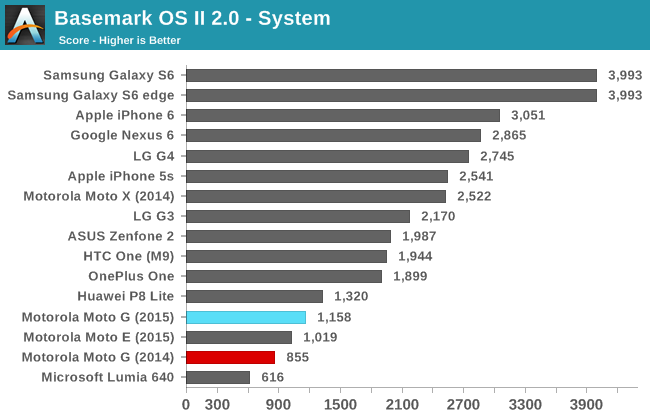
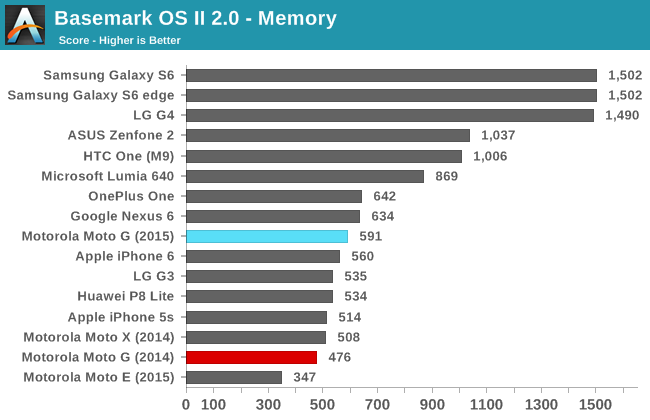

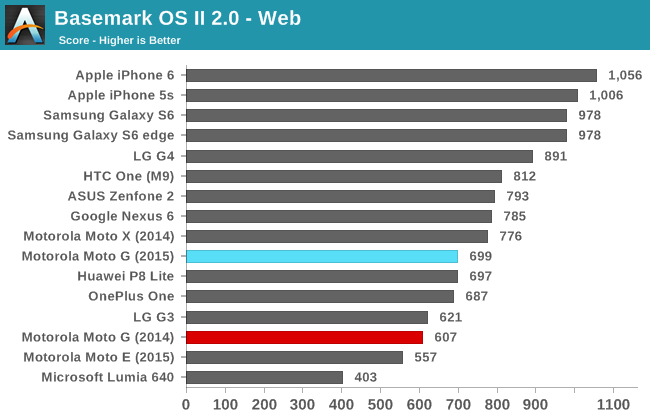
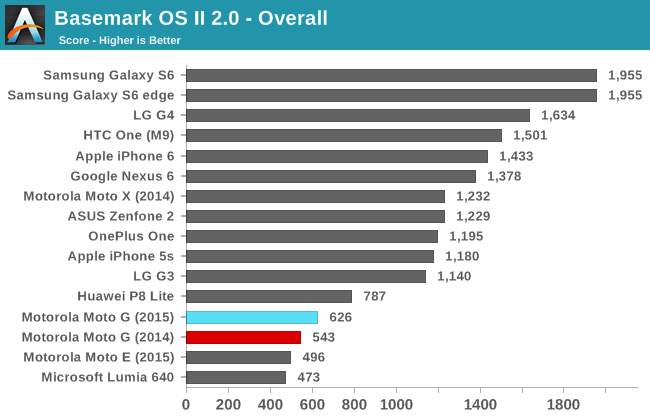
The Moto G doesn't perform as well in BaseMark OS II as it does in PCMark. While there's still good performance in the web and NAND memory sub-tests, performance lags in the system sub-test which stresses CPU and memory, and the graphics test score is very low due to how slow the Adreno 306 GPU is.
The Moto G's general performance is pretty good for a device of this price. There's a good level of improvement over the Moto E's performance, with the gap between the new Moto G and the 2014 model being even larger. The ASUS Zenfone 2 still has the best performance of a $200 smartphone, but it's something of an anomaly, and barring it the Moto G provides the best general performance that you'll see at this price point.










90 Comments
View All Comments
3DoubleD - Wednesday, August 19, 2015 - link
Thanks for the response!1. The 5W charging time would be great! Thanks for adding that.
2. I agree, it is too bad they are hamstringing the GPUs in these devices. Three generations of Moto G including the same GPU is pretty disappointing. It seems Motorola is keeping customers interested in AAA gaming on their more expensive phones, which is understandable. From what you are saying, it sounds like the poor display calibration and poor visibility in sunlight would be more apparent to non-gamers than the GPU.
3. What I'm referring to is your comments in the concluding remarks: "The waterproofing is definitely a neat addition, but I think in most cases it's just a nice thing to have rather than a selling point. Once waterproofing is accompanied by the ability to use the display when it's really wet I'll be a lot more interested in it." I suspect many people will see waterproofing as a selling point (AKA a desirable feature) just from a pure ruggedness standpoint. Instances where people are deciding between several mid-range Android phones and pick the Moto G based on it being waterproof are probably more likely than decisions based on many of the other specs.
4. My problem with device thinness is that the benefit of thinner and thinner devices is dubious, yet the benefit for keeping the same thickness, or even increasing it, is substantial. I don't think a objective argument can be made for why a 6.9 mm phone is better than a 8 mm phone or even an 11.6 mm phone (like the Moto G). Even the subjective 'design' argument is pretty shaky, considering everyone was swooning over smartphone designs that first made it to 10 or 11 mm.
So as leading reviewer of phones and a spokesperson for the masses, I'd challenge you to develop a metric for phone thickness that equally considers 'thin design' with ease of use and battery life. IMO manufacturers hit the thin-enough-to-be-usable limit years ago. Let's stop praising thinness-at-all-costs in reviews (as is typical in a flagship Android or iPhone review) and start making a big deal when the design needlessly sacrifices battery life for thinness.
djc208 - Wednesday, August 19, 2015 - link
Seems to me the one major category that is missed between those two phones is support. More and more I'm just as interested in how it will be supported, and I wonder how well the Zenphone will be supported against future OS updates. I'd tend to lean toward Motorola for long term support. LG brought be in with great hardware but turned me off with crappy software support.Moto1 - Wednesday, August 19, 2015 - link
Zero support from Motorola. Emailed and called and all I get is generic replys-not related to my question. I bought the first moto g in anticipation of fast updates and have had zero-which sucks cause I was promised 5.0 over a year ago.Machete - Thursday, August 20, 2015 - link
False, we have a 1g Moto G in family and it was updated to 5.0 months ago.tipoo - Sunday, August 23, 2015 - link
Must be your carriers fault. My first gen G has been rocking 5 for months.tipoo - Wednesday, August 19, 2015 - link
MicroSD and 2GB RAM were the two things I sorely missed in my first gen G, so this looks like a fair upgrade. Honestly, it's all the phone most people need. Even the weak GPU runs most modern Android games well. The RAM was always the bigger issue than the processing speed, and the minor bump to the latter will be a nice bonus.Now just bring Moto Maker for the G to Canada and take my money, Motorola!
YukaKun - Wednesday, August 19, 2015 - link
So... Is this better than my SGS2? Y know the CPU is better, but is the camera and GPU?I'm having a considerable loss in battery life as of late (from 3 days to just 2) and the S2 is still running anything I need it to (GMail, GMaps and other "light" stuff) with no hiccups. So in my mind, instead of getting a battery replacement, maybe jumping to the MotoG 2015 might be a good idea.
Cheers!
a1exh - Wednesday, August 19, 2015 - link
Battery replacements are soooo cheap for the SGS2 though. If it is still going and you're happy. The SGS2 camera was better than the MotoG 2013a1exh - Wednesday, August 19, 2015 - link
As a MotoG 2013 customer I wanted the 2015 to be great. But it isn't. So the Vodafone Smart Ultra 6 is looking like the PAYG phone to get in the UK only it is a bit bigmkozakewich - Wednesday, August 19, 2015 - link
Devices like this really highlight the need for colour correction on Android. If it can fill the full sRGB gamut, the only thing left is to tell it where to put the colours. There's no reason something like this shouldn't be able to pull a dE2000 of 1.I remember the review of the Stream 7. Since it ran Windows, they were able to run a correction suite on it, and it ended up with a really good score despite its inability to saturate the blues.